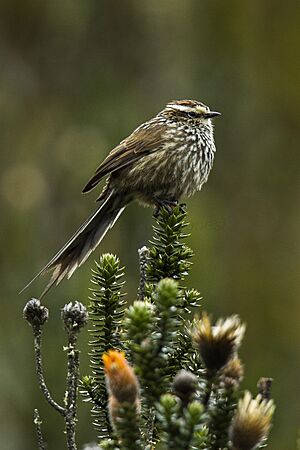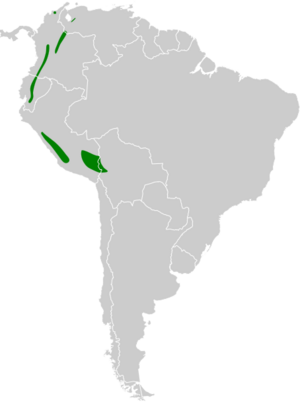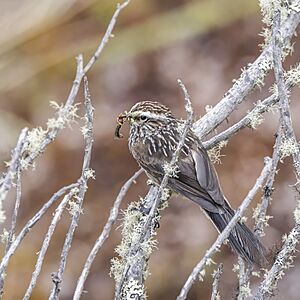Andean tit-spinetail facts for kids
Quick facts for kids Andean tit-spinetail |
|
|---|---|
 |
|
| Conservation status | |
| Scientific classification | |
| Genus: |
Leptasthenura
|
| Species: |
andicola
|
 |
|
The Andean tit-spinetail (Leptasthenura andicola) is a small bird that lives in the Andes mountains. It belongs to the ovenbird family called Furnariidae. You can find this bird in several South American countries, including Bolivia, Colombia, Ecuador, Peru, and Venezuela.
Contents
Meet the Andean Tit-Spinetail Family
Birds are often grouped into different types, and the Andean tit-spinetail has five main groups, called subspecies. Think of them like different branches of the same family tree! Each subspecies has slight differences, often based on where they live.
- L. a. certhia
- L. a. extima
- L. a. exterior
- L. a. andicola (This is the main group, called the "nominate" subspecies)
- L. a. peruviana
What Does the Andean Tit-Spinetail Look Like?
This bird is quite small, usually about 15 to 17 centimeters (6 to 7 inches) long. It weighs around 15 to 16 grams (about half an ounce), which is like a few quarters! It has a small body, a long tail, and a short beak. Both male and female birds look very similar.
The main subspecies, L. a. andicola, has a wide white stripe above its eye, called a supercilium. Its face is mostly dark gray-brown with streaks. The top of its head is a rich reddish-brown with black streaks. Its back is dark gray-brown with clear white or whitish streaks.
Its wings are dark brownish, with faint reddish edges on some feathers. The two middle tail feathers are long and pointed, making the tail look a bit forked. The rest of the tail feathers are dusky brown or blackish with buffy (light yellowish-brown) outer edges.
The bird's throat is white or whitish. Its chest and belly are gray-brown with many white or whitish streaks. These streaks become less clear on its sides and lower belly. Its eyes are dark brown to reddish-brown. Its beak is black, with the bottom part being a bit lighter. Its legs and feet are dark gray to black.
Young Andean tit-spinetails look a little different. They have fewer or no streaks on their heads. Their bellies might look mottled or scaly instead of streaked.
Subspecies Differences
The other subspecies have small variations in their colors and patterns:
- L. a. extima is smaller, with a narrower, buffier stripe above its eye. Its wing feathers have brighter cinnamon-brown edges.
- L. a. certhia has a whiter stripe above its eye and lighter streaks on its head. Its throat and chest are whiter, and its underparts are grayer.
- L. a. exterior has a brighter reddish-brown head with black streaks. It also has wider white streaks on its back and a whiter throat.
- L. a. peruviana has a less streaky face and a paler head with narrower black streaks. Its wing feathers have wider buff edges, and its chest and belly are darker.
Where Does the Andean Tit-Spinetail Live?
The Andean tit-spinetail lives in different areas across the Andes mountains, from Venezuela all the way down to Bolivia. It doesn't live in one continuous area, but in separate patches.
Specific Locations for Each Subspecies
- L. a. certhia: Lives in the Andes mountains in western Venezuela.
- L. a. extima: Found in an isolated mountain range in northern Colombia called the Sierra Nevada de Santa Marta.
- L. a. exterior: Lives in Colombia's Eastern Andes.
- L. a. andicola: Found in Colombia's Central Andes and continues south through the Andes of Ecuador.
- L. a. peruviana: Lives in the Andes of western and southern Peru, extending into Bolivia.
What Kind of Places Do They Like?
These birds usually live in dry or semi-dry mountain areas with lots of shrubs and bushes. In the northern parts of their range, they also live in humid grasslands and high-altitude grasslands called páramo. You can also find them in Polylepis woodlands, which are forests with special trees that grow at high elevations.
They live at very high altitudes:
- In Venezuela, they are found between 3,400 and 4,400 meters (11,150 to 14,430 feet) high.
- In Colombia, between 3,000 and 4,200 meters (9,840 to 13,780 feet).
- In Ecuador, between 3,200 and 4,000 meters (10,500 to 13,120 feet).
- In Peru, between 3,500 and 4,200 meters (11,480 to 13,780 feet).
- In Bolivia, between 3,500 and 4,450 meters (11,480 to 14,600 feet).
How Does the Andean Tit-Spinetail Behave?
Movement and Daily Life
The Andean tit-spinetail stays in the same area all year long. It does not migrate to other places.
What Do They Eat?
These birds mostly eat arthropods, which are creatures like insects and spiders. We don't know all the details of their diet yet. They usually search for food in pairs or small groups. Sometimes, they might join other bird species to look for food together.
They are very active when they forage! They hop along branches, picking food from leaves, flowers, and twigs. They often hang upside down to catch their prey.
How Do They Raise Their Young?
The breeding season for the Andean tit-spinetail isn't fully known, as it changes depending on the area. But generally, it seems to be between May and December.
They build a cup-shaped nest using grass and moss. Inside, they line it with animal fur, soft seed fluff, and feathers to make it cozy. They place their nests in different spots: on the ground, in a small cave or hole covered by plants, or even under the edge of a building. Sometimes, they use burrows dug by other animals or birds.
Usually, they lay two eggs. The eggs hatch after at least 16 days. We don't know how long it takes for the young birds to be ready to fly. Both parents help feed the baby birds in the nest.
What Sounds Do They Make?
The song of the Andean tit-spinetail is described as a series of notes that go lower in pitch. It often starts and ends with a trill, which is a rapid vibrating sound. Some people describe it as a "tinkling trill."
Their calls include weak, tinkling sounds like "téz-dit" or "téz-dit-dit." They also make fine "zik," "ti," or "tic" notes. Sometimes, they even make a high-pitched squeal that sounds a bit like a small mammal.
Is the Andean Tit-Spinetail Safe?
The IUCN (International Union for Conservation of Nature) has looked at the Andean tit-spinetail and decided it is a species of "Least Concern." This means they are not worried about it becoming endangered anytime soon.
This bird lives across a very large area. Even though we don't know exactly how many there are, scientists believe their population is stable. No immediate threats have been found that would put them in danger. They are considered quite common and are likely not much affected by human activities, except for local habitat loss in some places.



